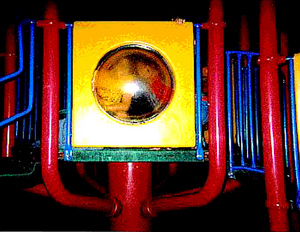Children will learn basic addition early in elementary school. This is a building block for multiplication, which is related to addition. I will explain basic multiplication and give tips that parents can use to assist their children in learning this important concept in mathematics.
Suppose there are 3 piles with 5 items in each pile. We can count the total number of items 1, 2, 3, 4, until the last item is counted and we get 15. We can also add the total in each pile to get 5 + 5 + 5 = 15. There is a third way to get the total number of items which is related to addition. That is multiplication. Since there are 3 piles, with 5 objects in each pile, we can say “3 multiplied by 5″,”3 times 5” or “3 x 5”, which is also 15.
If there were 4 piles of 5, there would be 20 items and we can say “4 times 5” or “4 x 5” = 20. When there are 5 piles of 5, the total is 25. The number of items increase by 5 every time we add another pile of 5.
Here are the multiplication tables for 5.
5 x 1 = 5
5 x 2 = 10
5 x 3 = 15
5 x 4 = 20
5 x 5 = 25
5 x 6 = 30
5 x 7 = 35
5 x 8 = 40
5 x 9 = 45
5 x 10 = 50
5 x 11 = 55
5 x 12 = 60
There is an important rule shown in the multiplication tables. Any number multiplied by 0 is equal to 0, and is not included in the multiplication table. Any number multiplied by 1 is itself.
Here are the multiplication tables for 1 through 12.
1 x 1 = 1, 2 x 1 = 2, 3 x 1 = 3, 4 x 1 = 4 , 5 x 1 = 5, 6 x 1 = 6, 7 x 1 = 7
1 x 2 = 2, 2 x 2 = 4, 3 x 2 = 6, 4 x 2 = 8, 5 x 2 = 10, 6 x 2 = 12, 7 x 2 = 14
1 x 3 = 3, 2 x 3 = 6, 3 x 3 = 9, 4 x 3 = 12, 5 x 3 = 15 6 x 3 = 18, 7 x 3 = 21
1 x 4 = 4 , 2 x 4 = 8, 3 x 4 = 12 , 4 x 4 = 16, 5 x 4 = 20 6 x 4 = 24, 7 x 4 = 28
1 x 5 = 5, 2 x 5 = 10, 3 x 5 = 15, 4 x 5 = 20, 5 x 5 = 25 6 x 5 = 30, 7 x 5 = 35
1 x 6 = 6, 2 x 6 = 12, 3 x 6 = 18, 4 x 6 = 24, 5 x 6 = 30 6 x 6 = 36, 7 x 6 = 42
1 x 7 = 7, 2 x 7 = 14, 3 x 7 = 21, 4 x 7 = 28, 5 x 7 = 35 6 x 7 = 42, 7 x 7 = 49
1 x 8 = 8, 2 x 8 = 16, 3 x 8 = 24, 4 x 8 = 32, 5 x 8 = 40 6 x 8 = 48, 7 x 8 = 56
1 x 9 = 9, 2 x 9 = 18, 3 x 9 = 27, 4 x 9 = 36, 5 x 9 = 45 6 x 9 = 54, 7 x 9 = 63
1 x 10 = 10, 2 x 10 = 20, 3 x 10 = 30, 4 x 10 = 40, 5 x 10 = 50, 6 x 10 = 60, 7 x 10 = 70
1 x 11 = 11, 2 x 11 = 22, 3 x 11 = 33, 4 x 11 = 44, 5 x 11 = 55, 6 x 11 = 66, 7 x 11 = 77
1 x 12 = 12, 2 x 12 = 24 , 3 x 12 = 36, 4 x 12 = 48, 5 x 12 = 60, 6 x 12 = 72, 7 x 12 = 84
8 x 1 = 8, 9 x 1 = 9, 10 x 1 = 10, 11 x 1 = 11, 12 x 1 = 12
8 x 2 = 16, 9 x 2 = 18, 10 x 2 = 20, 11 x 2 = 22, 12 x 2 = 24
8 x 3 = 24, 9 x 3 = 27, 10 x 3 = 30, 11 x 3 = 33, 12 x 3 = 36
8 x 4 = 32, 9 x 4 = 36, 10 x 4 = 40, 11 x 4 = 44, 12 x 4 = 48
8 x 5 = 40, 9 x 5 = 45 , 10 x 5 = 50, 11 x 5 = 55, 12 x 5 = 60
8 x 6 = 48, 9 x 6 = 54, 10 x 6 = 60, 11 x 6 = 66 , 12 x 6 = 72
8 x 7 = 56, 9 x 7 = 63, 10 x 7 = 70, 11 x 7 = 77, 12 x 7 = 84
8 x 8 = 64 , 9 x 8 = 72, 10 x 8 = 80, 11 x 8 = 88, 12 x 8 = 96
8 x 9 = 72, 9 x 9 = 81, 10 x 9 = 90, 11 x 9 = 99, 12 x 9 = 108
8 x 10 = 80, 9 x 10 = 90 , 10 x 10 = 100, 11 x 10 = 110, 12 x 10 = 120
8 x 11 = 88, 9 x 11 = 99, 10 x 11 = 110, 11 x 11 = 121, 12 x 11 = 132
8 x 12 = 96, 9 x 12 = 108, 10 x 12 = 120 , 11 x 12 = 132, 12 x 12 = 144
There are a few things to notice when looking at the multiplication tables. Staring with the 1’s, each answer goes up by 1. We say that the multiples of 1 are 1,2,3,4,5,6, and so on. For the 2’s tables, each answer goes up by 2. The multiples of 2 are 2,4,6,8,10,12, and so on. For the 3’s tables, each answer goes up by 3. The multiples of 3 are 3,6,9,12,15,18, and so on. The same pattern is true for all the multiplication tables.
The answer to a multiplication problem is also called the product.Notice that any number multiplied by 10 ends in 0. It may seem hard to learn the whole table, but notice that 1 x 2 is the same as 2 x 1, 3 x 2 is the same as 2 x 3, and so on. When two numbers are multiplied it doesn’t matter which number comes first, the answer is still the same.
*Tips for parents
Buy or make multiplication flash cards for all the multiplication tables. Make sure your child can solve problems like those above correctly and consistently. You may also want to make up problems using groups of objects like in the beginning of the article . Once your child is quick and accurate and recreating the multiplication tables, he or she is ready for more advanced problems in multiplication.
This simple guide should help any child ha vin g difficulty understanding basic multiplication .




